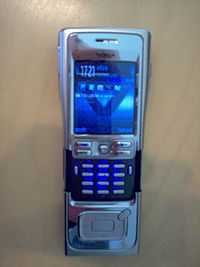Nokia N91
 | |
| Manufacturer | Nokia |
|---|---|
| Compatible networks | 802.11, GSM, GPRS, EDGE, WCDMA, Wi-Fi -- 802.11g |
| Availability by country | 2006 |
| Form factor | slider |
| Weight | 160 grams approx. |
| Operating system | Symbian OS v9.1 (Third Edition) |
| Memory | Hard disk |
| Battery | BL-5C, 3.7 V, 970 mAh |
| Data inputs | Standard Symbian Keypad (featuring green, red, menu, write, left & right selection/softkeys, joystick/pad, 1-# numerical) and XpressMusic keys |
| Display | 176 x 208, 262,144 colours TFT LCD |
| Rear camera | 2 Megapixels |
| Connectivity | 2G Networks/ 3G Networks depending on the model. |
The Nokia N91 is a mobile phone that was released to the public in April of 2006. It is part of the Nokia Nseries range of mobile phones. At the time of release, it was the most advanced music phone ever launched by nokia.[1] N91 also won the 'Most Innovative Product' award in recognition of its true multimedia music experience.[2] It features a 2-megapixel camera and a 4 GB (8 GB in a revision released later that year) hard drive to store approximately 3,000 songs encoded in either AAC, AAC+, eAAC+, MP3, mp3PRO, WAV, MIDI, or Microsoft's WMA format. It is generally considered the benchmark in the music department, simply for its unparalleled sound quality through headphones.[3] It also features 3G and Wi-Fi connectivity. The phone features a 176 x 208, 262,144 colours TFT LCD display and dedicated music functionality buttons (XpressMusic) that slide down to reveal traditional mobile phone keys. Battery life when solely playing music has been estimated at 12 hours.
In advertisements for the phone, Nokia recommended Bose and Sennheiser headphones.
An 8 GB variant, internally known as N91-2, was also released. This upgraded model features some minor improvements in addition to the extra storage space. The most prominent feature on the N91-2, apart from the increased memory, was the inclusion of A2DP Bluetooth Profile. This profile enabled wireless music playback over Bluetooth, in full stereo (2 different channels, L+R). Compatible Bluetooth headsets were already available in the market by then. N91-2 had a distinct black color, that added to its face value.
N91-5 was a version of the N91 with the 4 GB memory, but without Wifi (WLAN) and 3G Network support. It was produced by the Chinese Plant of Nokia Corporation. This model retailed for about 50 Euros less than the regular N91-1.
The N91 was discontinued late 2007 with the emergence of other N series audio convergent devices.
Operating system
The phone features the Symbian Series 60 Operating System. It was the first phone with the Symbian OS 9.1 operating system to be released.[4]
Audio quality
The Nokia N91 has been praised with an impeccable reputation of the best sounding mobile phone ever produced (the majority of stand alone portable music players can hardly compete with it either).[5] The audio reproduction is spot on and is comparable to high end music systems. It is also considered to have the loudest audio output on a mobile phone. It's 'Loudness' and 'Stereo widening' effects, when used together, provide astonishing tonal clarity and dynamic range. The Nokia N91 uses a special DSP-33 chip set made by Toshiba and a powerful in-built Harman Kardon amplifier to boost up its volume while maintaining acoustics, resulting in louder, deep bass and rich sound with perfect low, mid range & a slightly damped high range frequency which has not been achieved by any iPod or Sony Walkmans.[6] The slight damping in the high frequency is a boon for music listeners as it wont strain the ears even after prolonged use. This is one of the few standard hand held devices which can drive high end & higher impedance headset's with considerable volume. Test conducted, the N91 wins over iPod Nano in its signal to noise ratio, output power at full volume, and output at 10–100 Hz.[7]
Problems and criticisms
There have been a few problems with the N91, namely connecting the phone to a Macintosh computer. This will often cause the phone to crash as the two units are disconnected and music files are often not recognised despite being loaded into the phone's hard drive.[citation needed] Also, in old firmware versions, when you install a new theme, it will reset itself back to the default theme. Users can update the firmware using Nokia's PC Suite.
In the Philippines, there was an incident involving an N91 being used with one of Nokia's 46 million recalled BL-5C lithium-ion batteries,[8] and exploded as a result.[9]
References
- ↑
- ↑ Nokia's N91 and N92 awarded. Intomobile.com (2006-04-10). Retrieved on 2013-12-08.
- ↑ News.frbiz.com
- ↑ Gsmarena.com
- ↑ Gsmarena.com blog
- ↑ Forum2.mobile-review.com
- ↑ Thenokiaguide.com
- ↑ "Nokia issues BL-5C battery warning, offers replacement - Wikinews, the free news source". En.wikinews.org. Retrieved 2010-01-01.
- ↑ Nokia N91 cell phone explodes
External links
| Wikimedia Commons has media related to Nokia N91. |
- Official Nokia N91 product page
- Nokia N91 Press Release
- N91 Specifications from Symbian and Nokia
- Nokia N91 at WikiSpecs
Reviews
- Camera-Phones-Spot
- All About Symbian N91 review
- InfoSync World
- N91 Reviews and specifications roundup
- Howard Chui brief Nokia N91 review
- The Smartphones Show – N91 video review
- Mobile Today – Retailer Review
- Mobile-Review -
| |||||||||||||||||||||||||||||||||||||||||